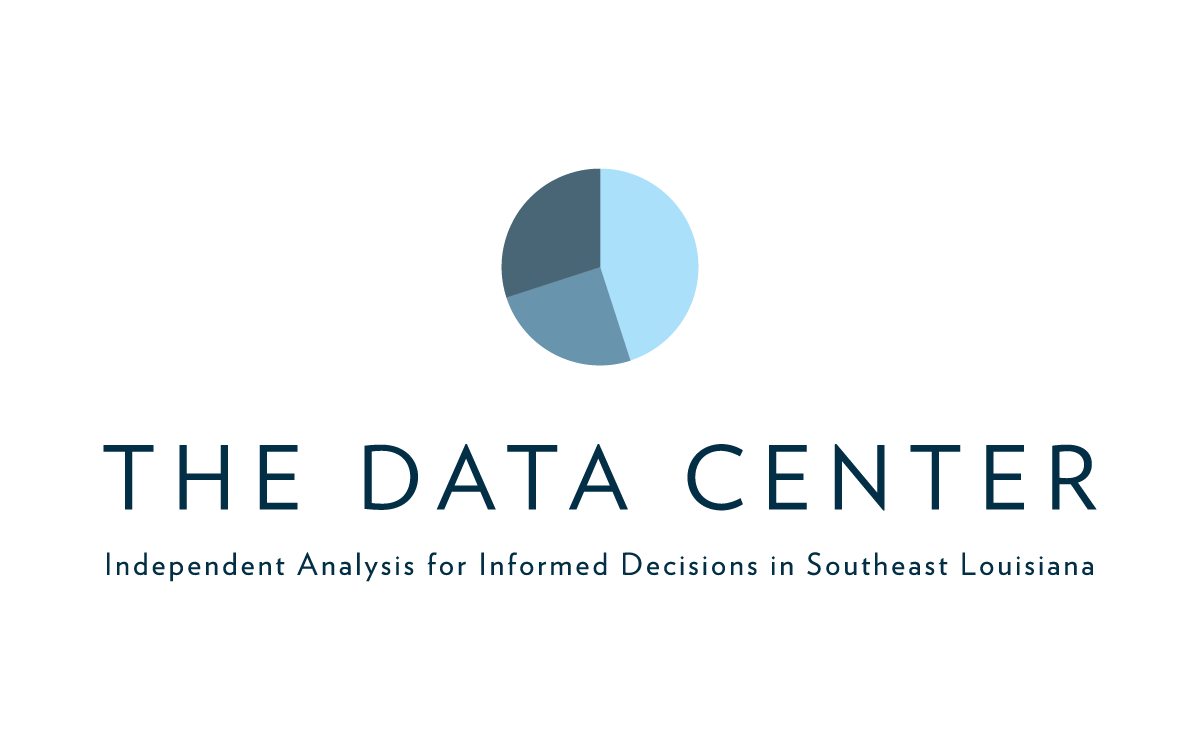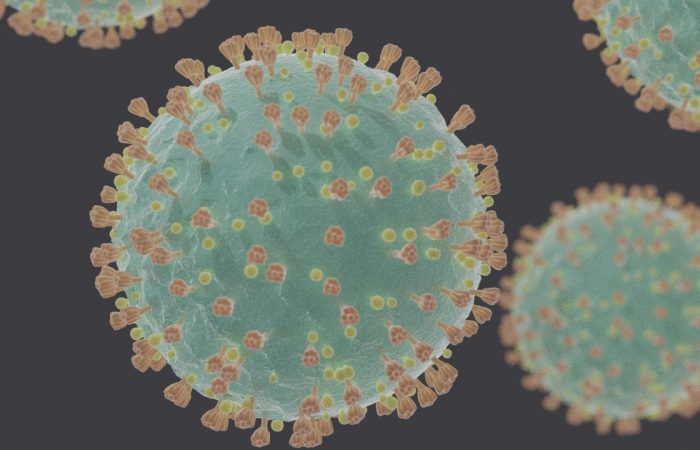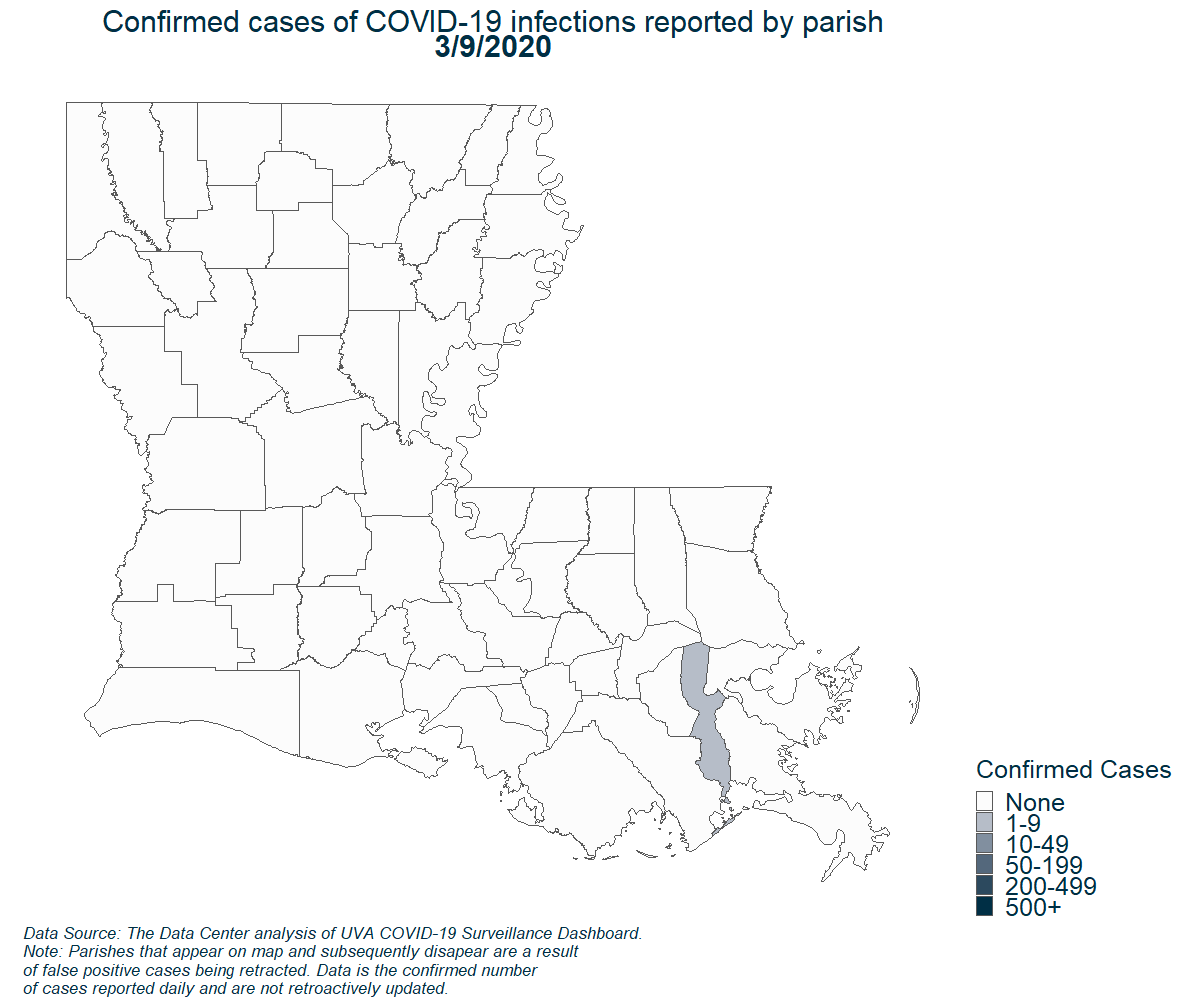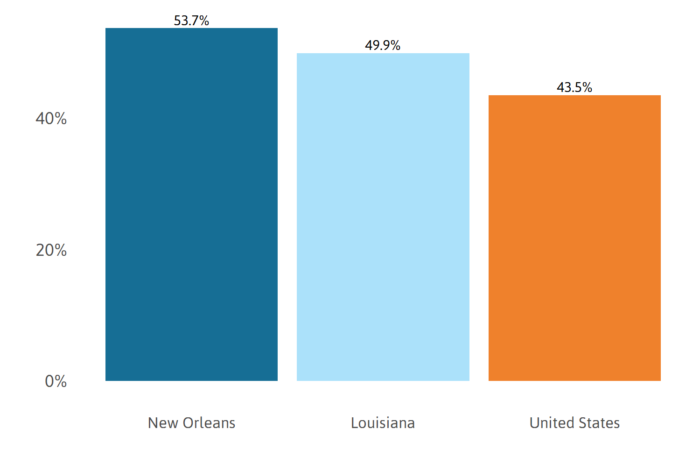One Year with COVID: Schools
Published: Jun 04, 2021
On March 16th, 2020, every public school in New Orleans closed for in-person instruction, requiring students be educated remotely. Abruptly shifting to a virtual learning environment—with little funding or time for planning and setup—was an immense undertaking that required the cooperation of parents, teachers, schools, city, state, and federal government.
Since then, public schools have looked to CDC and local government guidance along with COVID data to inform decisions on closings and re-openings. But for many New Orleanians, the experience has been confusing, frustrating, and burdensome. School closings have been a major disruption for children and families who rely on schools not just for education, but for social, behavioral, and mental health services, as well as childcare and food assistance. Fewer in-person school days for elementary students is associated with reductions in employment for working moms at the state level. Moreover, inconsistent decisions across the city about school re-openings compounded the challenges that parents and employers faced.
Most importantly, these shifts have had an impact on students’ lives and their ability to learn, and in many cases placed further hardships upon families that were disadvantaged before the pandemic. This brief summarizes the latest research on COVID transmissions in school settings, as well as the impacts of school closures on children, families, and the community as a whole, with the aim of informing decisions about public schools heading into the 2021-2022 school year.
COVID in schools
As communities grapple with the best way to get kids back into classrooms, a growing body of research suggests that, at least in terms of COVID, schools are among the safest places to be. But this only substantiates when appropriate mitigation measures are followed in schools and COVID’s spread is controlled in the greater community. When transmission is low in a community, there is little evidence that COVID-19 is transmitted to any significant degree in school settings. As cases in a community rise to moderate and high levels, cases detected among students and school staff also grow. In New Orleans, cases reached record highs following the 2020-2021 winter holidays, with 1,499 reported cases the week of January 4th. That same week, New Orleans Public Schools also reported a record-breaking 103 new cases among students and staff. As cases in the community dwindled in late March and early April of 2021, so did cases in schools.
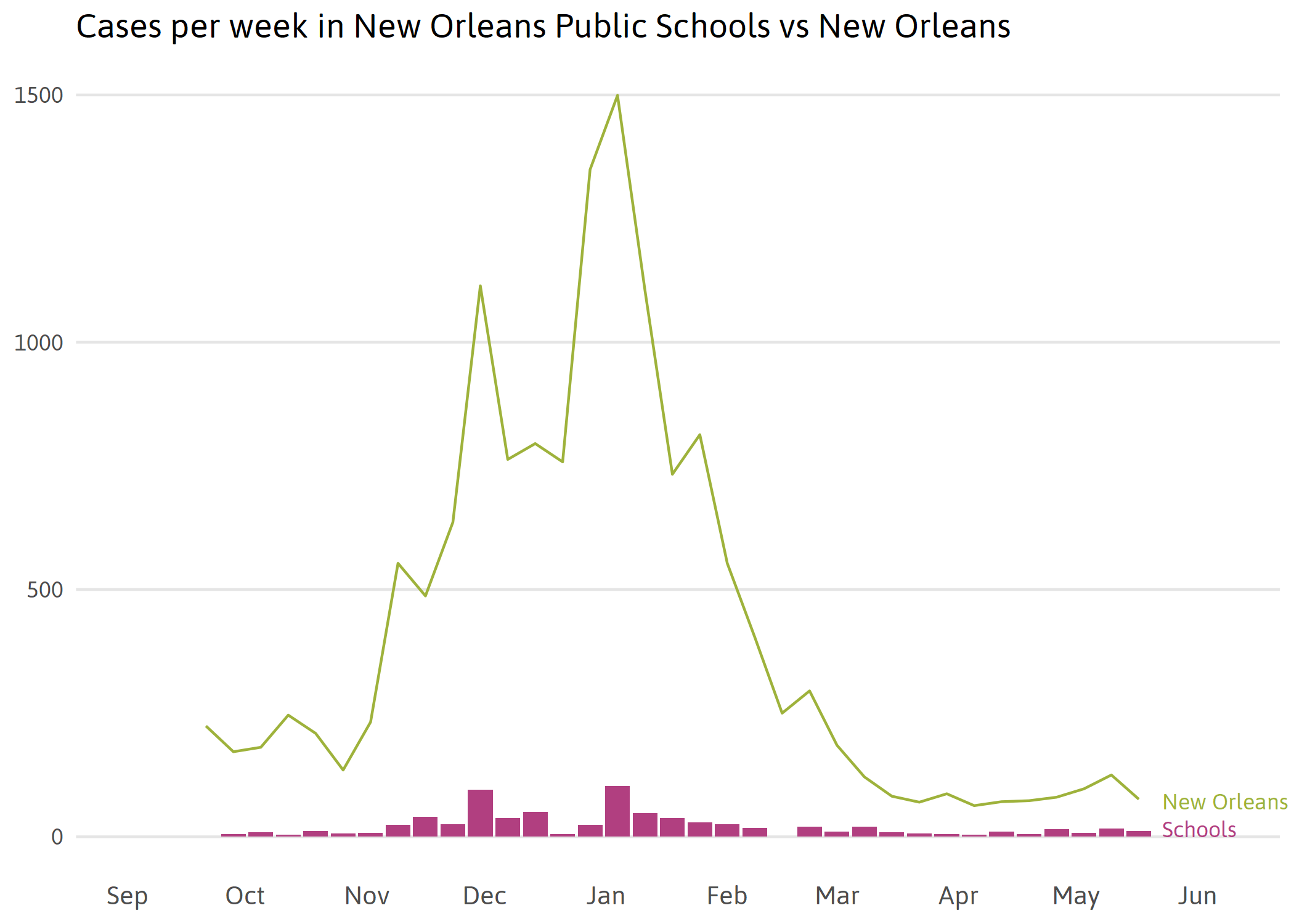
Even when COVID-19 cases are detected by schools, most are acquired in the community, and very few result in in-school transmission when sufficient prevention strategies are adhered to. Much of in-school transmission happens between staff. Spread between students and from students to staff within the school setting is rare when appropriate mitigation measures are followed.
The most comprehensive study of in-school transmission followed 8,598 North Carolinian students and staff over nine weeks of in-person learning during the fall 2020 semester. There were 773 community-acquired cases detected by the school during that time, and only 32 cases of secondary transmission in schools. Notably, there was no transmission from children to adults within the school setting. This success was achieved by deploying layered prevention strategies and ongoing monitoring that supported mid-course corrections. Students, parents, and staff were expected to adhere to the 3Ws: wear a mask, wait six feet apart, and wash hands. Contact tracing, testing, and quarantine procedures were also utilized. Data was reviewed regularly, and strategies were adapted as needed. The in-school adult population posed the most significant challenges to success. Overtime, adults exhibited reduced compliance with the 3Ws and cooperated less with contact tracers to avoid quarantine. The school districts addressed this by holding more meetings to reinforce the importance of long-term adherence for parents, faculty, and staff.
New variants and kids
Research about why COVID is less transmissible among children is still nascent, but early findings suggest that children have fewer receptors where the virus can bind. As a result, people under 20 are about half as susceptible to COVID infection as people over 20 years of age. Much of our understanding of COVID in children is based on research conducted before new, more contagious variants emerged. Unfortunately, some new variants contain mutations that improve its ability to latch onto host cells and, thus, may be more infectious in all age groups, including children. In recent weeks, kids 5-17 throughout Region 1 (defined by the Louisiana Department of Health as Orleans, Jefferson, St. Bernard, and Plaquemines parishes) have been responsible for a larger contribution of overall cases than ever before in our region.
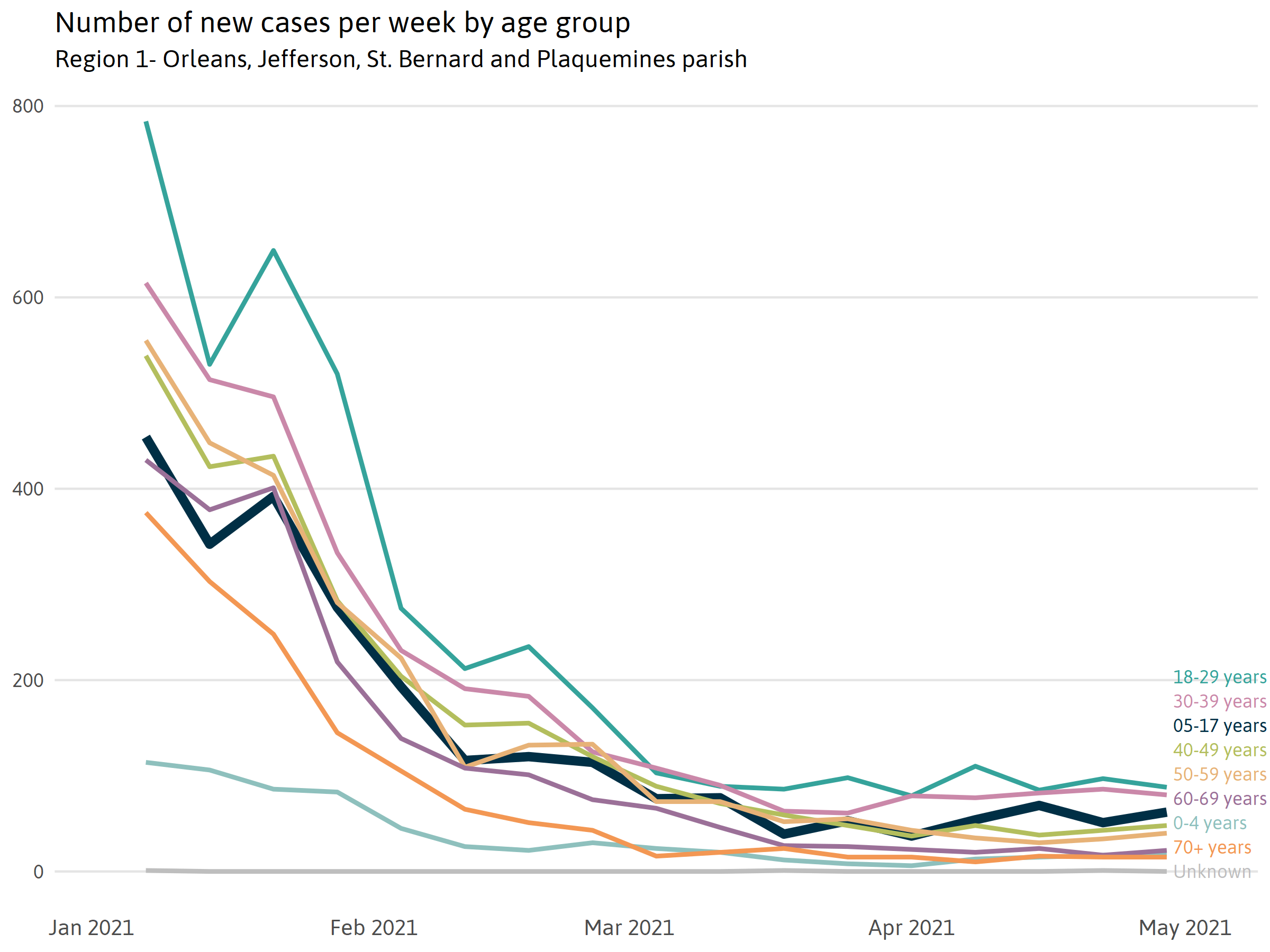
Younger children may account for a growing share of cases because they are among the only age groups currently not eligible for the vaccine. On May 10th, Pfizer received emergency FDA approval for their vaccine for children ages 12 to 15. Moreover, Pfizer plans to seek emergency FDA approval for children ages 2 to 11 in September. It will be important to monitor children’s susceptibility to new variants and access to vaccines when planning for the 2021-2022 school year.
Learning loss
When the order was given to close schools across the state in March of 2020, it was announced as a four-week closure for in-person instruction, but ultimately school buildings remained closed for most students until the fall semester. The NOLA Public School district mandated that schools stop in-person classes and provide “remote learning” for the last two months of spring instruction in 2020, but starting with the 2020-2021 school year, charter schools in New Orleans were able to determine their own opening procedures and schedules within local, state, and federal guidelines. The NOLA Public School district guidance prioritized full-time in-person learning for students with disabilities and grades K-4, then expanded to older children as feasible, given constrained capacity mandates. Those students who could not be accommodated because of constrained capacity, or because families were not ready to return to in-person learning continued to participate in distance learning.
Prior to the pandemic, studies on student performance in virtual and online learning yielded mixed findings. One meta-analysis concluded that students self-selected to attend virtual and online schools making the findings difficult to generalize to entire student populations. But one longitudinal study that followed all students who attended at least one year of virtual or online school found that overall, these students scored worse on standardized tests in English and math, and were 10 percent less likely to graduate.
After COVID struck, studies of student learning conducted at the start of the 2020-2021 school year found that students made some learning gains at the end of the previous school year despite school closures, but these gains were likely less than they would have been had they been in the classroom.
Importantly, many New Orleans students are negatively impacted by the Digital Divide—inequities regarding access to or use of information and communication technologies. Before the pandemic, 20 percent of children under 18 in New Orleans households did not have access to a computer or broadband internet connection at home, which is needed to fully participate in online classes. During COVID, many students simply missed school altogether. An analysis of enrollments reported to the Louisiana Department of Education in February 2020 and February 2021, showed that there were 1,580 fewer students attending public schools in New Orleans, a reversal of post-Katrina trends showing increasing enrollments in NOLA Public Schools. Minority students were disproportionately likely to be missing from school altogether. The drop in Black student enrollment was particularly severe with 1,505 fewer Black students enrolled in New Orleans Public Schools, accounting for 95 percent of the decrease in enrollment numbers. Black students represent just 80 percent of the students attending public schools in New Orleans.
After returning from school closures after the winter break, NOLA Public Schools reported that nearly one-third of students had missed more than 10 days of school, and that daily attendance was only averaging 83.5 percent systemwide. Many of the causes of chronic absenteeism prior to COVID-19 were outside the control of the school, including poverty, homelessness, family instability, peer influence, and individual mental and behavioral health issues. For many students these patterns of absenteeism continued or became worse during the pandemic and resulted in increased absences and further lost learning time. Missing school is associated with decreased likelihood of passing classes, graduating, and attending college.
The long-term consequence of lost learning is most severe for children in lower grades. Reading skills in the third grade are highly predictive of future academic performance, because students learn by reading in later grades. Reducing learning by one-third of a school year in Grade 3 is estimated to reduce learning by a year when that cohort reaches Grade 10. Disentangling the effect of virtual learning on different segments of our population is an area ripe for additional study, especially after the results from spring 2021 standardized testing become available.
Role of schools in the community
Schools provide value far beyond academics. They also support children’s social-emotional and physical needs. In the spring of 2020, teachers and school administrators strained to continue educating New Orleans’ youth virtually, but the schools’ role as caregiver while parents are working, was also temporarily lost.
The sometimes-overlooked value of physically being in school quickly became evident as schools shut down in March of 2020—particularly for single parents and those who found themselves managing work and their kids’ education at the same time.
Single parents sometimes don’t have as much available time to spend assisting children with remote learning. In New Orleans, 66 percent of children under 18 who live with their parents, live in a single-parent household, compared to 34 percent nationally. As result, a disproportionately large percent of students in the city had less parental guidance at home to navigate distance learning and other aspects of adolescence that schools support.

Note: This graphic depicts only children living with one or both parents. Of all New Orleans children living in households, 13.7 percent live with a grandparent (as householder), 3.9 percent live with other relative householder, 1.5 percent live with non-relative householder, 36.9 percent live with a married couple, 6.3 percent live with a single male, and 50.1 percent live with a single female. Literature on the impact of COVID-19 on other household types is limited, and, thus, beyond the scope of this brief.
Furthermore, 76 percent of children living in single-parent households are being cared for by a single parent who also works. In other words, half of all children in New Orleans who live with their parents, live with a single parent who also works. Of the 34 percent of children in New Orleans who live with two parents, 78 percent live in households where both parents work. Taken together, 77 percent of New Orleans children live in a household where every parent in the household works, potentially leaving little time to provide guidance (and technical support) for children struggling to participate in classes online. In short, in-person schooling provides critical childcare support to working parents while providing children with an environment where consistent and focused attention can be given to support learning.
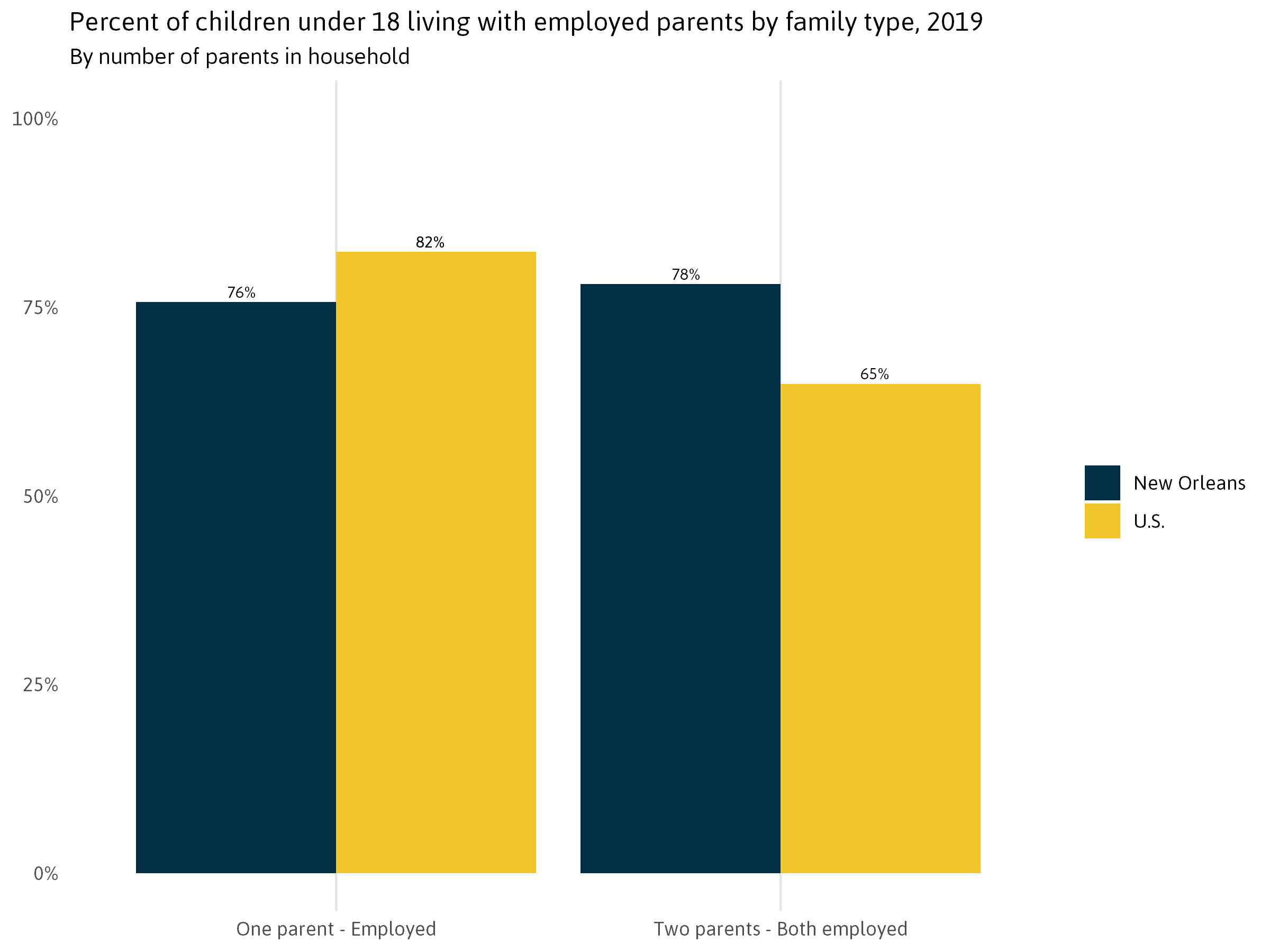
Beyond childcare, schools also provide mental health services, food access, and development opportunities for children. Students who struggle to access virtual learning are also more likely to depend on school-support resources such as after-school programs, special education, and school lunches. In February 2020, before the COVID-19 lockdown, more than 84 percent of students attending public schools in New Orleans were considered economically disadvantaged and eligible for federally funded free or reduced lunch. In many cases school nurses provide frontline healthcare, and additional staff provide social and behavioral counseling to students. Schools also provide a wide range of services for students with disabilities. Children with disabilities are more likely to have adverse childhood experiences, including being bullied. The services schools provide for these students in-person are exceptionally important to their health and well-being and are among the most difficult to substitute virtually.
Inequity
Experience during previous disasters has shown that systemic inequities often worsen negative disaster-related outcomes for disadvantaged members of society. During COVID, children who were already struggling were more likely to fall behind, low-wage workers were the first to lose their jobs, and the responsibility of childcare largely fell along gender lines with mothers disproportionately responsible for shouldering the load.
As the pandemic first started, the supply of available seats at early childhood centers disappeared with many parents working essential jobs struggling to find care for their children. Finding childcare during the pandemic was difficult for parents whose children were participating in K-12 distance education as well. Studies suggest that mandatory preschool closures and reduced class-size increased the unemployment rate among mothers. While these problems were most acute at the start of the pandemic, they were still prevalent after the start of the 2020-2021 school year. A Pew Research poll from October 2020 showed that most parents reported that handling childcare responsibilities was now more difficult compared to before the pandemic, and women were more likely to report this than men. Women and single parents are most susceptible to economic shocks from school closures and a lack of early childcare. Similar to the rate of single-parent households, 42 percent of children in New Orleans live in a household with a single working mom, double the national rate.
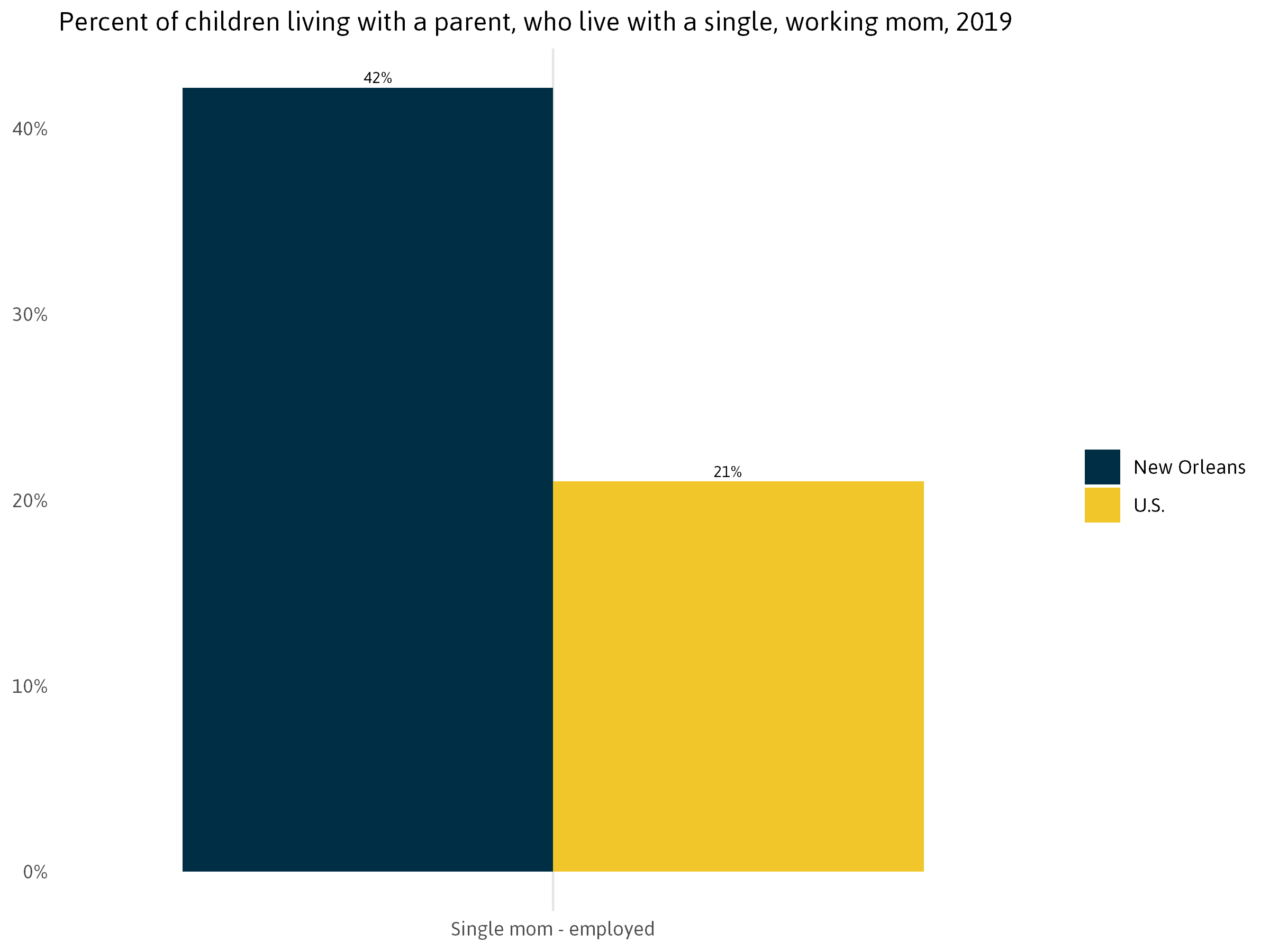
While Black and Hispanic households in New Orleans are more likely to have school-aged children, they are also more likely to be headed by a single parent and earn substantially less money. Statewide data indicates Black and Hispanic adults have been less able to substitute in-person work for telecommuting throughout the pandemic. Black and Hispanic households are also less likely to have a computer or dependable Internet service to access school virtually. Assisting young students with virtual learning is especially challenging for caretakers who have fewer resources and less flexible in-person work responsibilities.
Lessons learned
Children and families who were struggling before the pandemic were the most likely to suffer negative economic, educational, and social impacts, which are likely to compound over time. For better or for worse, public schools provide important safety-net services for children and parents, as well as critical child supervision for working parents. And of course, the primary role of New Orleans public schools is to educate the city’s youth. For all these reasons, it’s important for schools to remain open for the well-being of both students and working parents.
As controlling COVID in the greater community is the best way to ensure COVID does not spread through schools, the community needs to remain cautious and continue minimizing community spread. New Orleanians of color have borne a disproportionate brunt of the COVID-19 pandemic thus far, from infections to hospitalizations and death. These health disparities extend to children as well. While young children seem to be less susceptible to COVID, Hispanic, Black, and children with pre-existing conditions are at an increased risk of severe outcomes, including Multisystem Inflammatory Syndrome (MIS-C), when infected. Careful attention must be paid to mitigating spread, but also making up for lost time in the classroom to avoid causing further burden on already disadvantaged populations.
Research on new variants, including how they can or will transmit in schools, is sparce to date. Until more is known, schools should prepare to start the fall 2021 semester with mask mandates, social distancing, and frequent testing protocols in place. In all likelihood, these precautions will need to be followed until we know more about how new variants of COVID-19 spread among children, and until vaccines are available to all children. Considerations around health, racial and gender equity should play an integral role in the complex decisionmaking process related to resuming in-person instruction.
Sources and Notes
Landivar, L. C., Ruppanner, L., Rouse, L., Scarborough, W., & Collins, C. “Public School Operating Status During the COVID-19 Pandemic and Implications for Parental Employment,” 2021
”Science Brief: Transmission of SARS-COV-2 in K-12 Schools,“ CDC, last modified March 19, 2021, https://www.cdc.gov/coronavirus/2019-ncov/science/science-briefs/transmission_k_12_schools.html
Marielle J Fricchione, Jennifer Y Seo, and M Allison Arwady, “Data-Driven Reopening of Urban Public Education Through Chicago’s Tracking of COVID-19 School Transmission,”. J Public Health Manag Pract. 2021 May-Jun 01;27(3):229-232, https://pubmed.ncbi.nlm.nih.gov/33394643/
Falk A, Benda A, Falk P, Steffen S, Wallace Z, Høeg TB. ”COVID-19 Cases and Transmission in 17 K–12 Schools — Wood County, Wisconsin, August 31–November 29, 2020,“ MMWR Morb Mortal Wkly Rep. January 29, 2021: 70(4):136-140
Sharif A Ismail, Vanessa Saliba, Jamie Lopez Bernal, Mary E Ramsay, and Shamez N Ladhani, ”SARS-CoV-2 infection and transmission in educational settings: a prospective, cross-sectional analysis of infection clusters and outbreaks in England,” Lancet Infect Dis. March 2021: 21(3):344-353
Gandini S, Rainisio M, Iannuzzo ML, Bellerba F, Cecconi F, and Scorrano L., “No evidence of association between schools and SARS-CoV-2 second wave in Italy,” last modified January 08, 2021; https://doi.org/10.1101/2020.12.16.20248134
Stein-Zamir C, Abramson N, Shoob H, et al, ”A large COVID-19 outbreak in a high school 10 days after schools’ reopening, Israel,“ Euro Surveill. (May 2020);25(29):2001352. doi:10.2807/1560-7917.ES.2020.25.29.2001352
Zimmerman KO, Akinboyo IC, Brookhart A, et al., “Incidence and Secondary Transmission of SARS-CoV-2 Infections in Schools,” Pediatrics. (January 2021); e2020048090. doi:10.1542/peds.2020-048090
Yung CF, Kam KQ, Nadua KD, et al., ”Novel coronavirus 2019 transmission risk in educational settings,” Clin Infect Dis. (June 2020); ciaa794. doi:10.1093/cid/ciaa794
Zimmerman KO, Akinboyo IC, Brookhart A, et al., ”Incidence and Secondary Transmission of SARS-CoV-2 Infections in Schools,” Pediatrics. (January 2021); e2020048090. doi:10.1542/peds.2020-048090
Patel, A. B., & Verma, A., ”Nasal ACE2 levels and COVID-19 in children,“ JAMA, (2020): 323(23), 2386-2387.
Davies, N. G., Klepac, P., Liu, Y., Prem, K., Jit, M., & Eggo, R. M., ”Age-dependent effects in the transmission and control of COVID-19 epidemics,” Nature medicine, 26(8), (2020): 1205-1211.
The Data Center analysis of Louisiana Department of Health data.
“Children and COVID-19: State Data Report” American Academy of Pediatrics and the Children’s Hospital Association. Last modified April 29, 2021, https://downloads.aap.org/AAP/PDF/AAP%20and%20CHA%20-%20Children%20and%20COVID-19%20State%20Data%20Report%204.29.21%20FINAL.pdf
”COVID-19 Vaccines for Children and Teens,” CDC, last modified May 27, 2021, Retrieved from: https://www.cdc.gov/coronavirus/2019-ncov/vaccines/recommendations/adolescents.html
Lesley McClurg, ”COVID Vaccine Trials Underway for Kids 5 and Younger,“ All Things Considered, NPR, May 17, 2021. Audio 3:59, https://www.npr.org/2021/05/17/997029362/clinical-trials-underway-for-5-and-younger-covid-19-vaccinations
NOLA-PS Announces Districtwide School Closure Due to COVID-19 (March 13, 2020), https://nolapublicschools.com/news/press-releases/nola-ps-announces-districtwide-school-closures-due-to-covid-19
NOLA Public Schools “Top 3 things to know: NOLA-PS Roadmap to Reopening“, (2020), https://nolapublicschools.com/images/New%20Folder%205/Reopening_Roadmap_OnePager_070120_FINAL.pdf?type=file
NOLA Public Schools “Roadmap To Reopening,“ last modified March, 2021, https://nolapublicschools.com/images/New%20Folder%205/NOLA_PS_Roadmap_to_Reopening_03312021_FINAL.pdf?type=file
Bueno, Carycruz. “Bricks and Mortar vs. Computers and Modems: The Impacts of Enrollment in K-12 Virtual Schools.” Computers and Modems: The Impacts of Enrollment in K-12 Virtual Schools (July 3, 2020).
Barbour, Michael K. “The state of K-12 online learning.” Technology in school classrooms: How it can transform teaching and student learning today (2017): 37-51.
Barbour, Michael. “The disconnect between policy and research: Examining the research into full-time K-12 online learning.” In Society for Information Technology & Teacher Education International Conference, pp. 1438-1445. Association for the Advancement of Computing in Education (AACE), 2015.
Bueno, Carycruz. “Bricks and Mortar vs. Computers and Modems: The Impacts of Enrollment in K-12 Virtual Schools.” Computers and Modems: The Impacts of Enrollment in K-12 Virtual Schools (July 3, 2020).
Angela Johnson, Megan Kuhfeld, and Beth Tarasawa, ”How did students fare relative to the COVID-19 learning loss projections?,” last modified January 18, 2021, https://perspectivesblog.sagepub.com/blog/research/how-did-students-fare-relative-to-the-covid-19-learning-loss-projections
Early estimates of learning loss due to COVID school shut-downs suggested that Louisiana students would start the 2020-2021 school year 6 months behind due to missing the last two months of in class instruction. But the effect of school closures were not as severe as predicted, most likely due to some schools reopening or implementing various forms of virtual learning.
The Data Center – “Who Lives in New Orleans and Metro Parishes Now?,” https://www.datacenterresearch.org/covid-19-data-and-information/demographic-data/
The Data Center analysis of 2019 American Community Survey 5-year estimates.
Data Center Analysis of Louisiana Department of Education Multiple Statistics By School System For Total Public Students https://www.louisianabelieves.com/resources/library/student-attributes
”State of Public Education in New Orleans: 2019-2020,” Cowen Institute, https://cowendata.org/reports/the-state-of-public-education-in–new-orleans-2019/enrollment
The Data Center analysis of Louisiana Department of Education, ”Multiple Statistics By School System For Total Public Students,” https://www.louisianabelieves.com/resources/library/student-attributes
Marta Jewson, “New Orleans school attendance rate improving, but one-third of students have missed 10 days of school or more,” The Lens, last modified April 1, 2021, https://thelensnola.org/2021/04/01/new-orleans-school-attendance-rate-improving-but-one-third-of-students-have-missed-10-days-or-school-or-more/
Hasselle, D, ”16% of New Orleans public school students miss class each day. Officials issue a ‘call to action’”, NOLA.com, accessed February 2020, https://www.nola.com/news/education/article_af9ce2c2-6570-11eb-8a6f-9ffe9da33000.html
Kearney, C.A. ”An Interdisciplinary Model of School Absenteeism in Youth to Inform Professional Practice and Public Policy,” Educational Psychology Review 20, (2008): 257–282. https://doi.org/10.1007/s10648-008-9078-3
Momero, Mariajose and Lee, Young-Sun, ”A National Portrait of Chronic Absenteeism in the Early Grades,” National Center for Children in Poverty, Columbia University – Mailman School of Public (2007)
Kearney, Christopher A. “School absenteeism and school refusal behavior in youth: A contemporary review.” Clinical psychology review 28, no. 3 (2008): 451-471.
Kaffenberger, Michelle. “Modelling the long-run learning impact of the Covid-19 learning shock: Actions to (more than) mitigate loss.” International Journal of Educational Development 81 (2021): 102326.
The Boston Foundation, “The Boston indicators project: Third grade reading proficiency,” (2014), https://www.bostonindicators.org/indicators/education
Leila Fiester, ”Early Warning Confirmed: A research update on third-grade reading,” http://www.aecf.org/resources/early-warning-confirmed/
”Critical Academic Indicators: What to Look for in Your Students to Ensure Future Success” Hanover Research, last modified August 26, 2014, https://www.hanoverresearch.com/insights-blog/critical-academic-indicators-what-to-look-for-in-your-students-to-ensure-future-success/
Kaffenberger, Michelle. “Modelling the long-run learning impact of the Covid-19 learning shock: Actions to (more than) mitigate loss.” International Journal of Educational Development 81 (2021): 102326.
Bansak, C., & Starr, M., ”Covid-19 shocks to education supply: how 200,000 US households dealt with the sudden shift to distance learning,” Review of Economics of the Household, 19 (1) (2021): 63-90.
”Operational Strategy for K-12 Schools through Phased Prevention,” CDC, last modified May 15, 2021, https://www.cdc.gov/coronavirus/2019-ncov/community/schools-childcare/operation-strategy.html?CDC_AA_refVal=https%3A%2F%2Fwww.cdc.gov%2Fcoronavirus%2F2019-ncov%2Fcommunity%2Fschools-childcare%2Fschools.html
The Data Center analysis of February 2020 Louisiana Department of Education ”Multiple Statistics By School System For Total Public Students,” https://www.louisianabelieves.com/resources/library/student-attributes
Jonathan Young, Ari Ne’eman, and Sara Gelser. “Bullying and Students with Disabilities: A Briefing Paper from the National Council on Disability,” National Council on Disability (2012).
Joline E, B., Lainie K, H., Susan D, A., Amy J, H., Robert, R., & Maurice G, S. ”School reopening during COVID-19 pandemic: Considering students with disabilities,“ Journal of Pediatric Rehabilitation Medicine, October 21, 2020: 1-7.
”Understanding Disaster Risk, Poverty and inequality,” PreventionWeb, https://www.preventionweb.net/disaster-risk/risk-drivers/poverty/
Zia Qureshi. ”Tackling the inequality pandemic: Is there a cure?,” Brookings Institution, last modified November 17, 2020, https://www.brookings.edu/research/tackling-the-inequality-pandemic-is-there-a-cure/
Emma Dorn, Bryan Hancock, Jimmy Sarakatsannis, and Ellen Viruleg, ”COVID-19 and learning loss – disparities grow and students need help,” McKinsey & Company, accessed December 8, 2020,https://www.mckinsey.com/industries/public-and-social-sector/our-insights/covid-19-and-learning-loss-disparities-grow-and-students-need-help
André Dua, Kweilin Ellingrud, Michael Lazar, Ryan Luby, Sanjay Srinivasan, and Tucker Van Aken, ”Achieving an inclusive US economic recovery,” McKinsey & Company, last modified February 3, 2021, https://www.mckinsey.com/industries/public-and-social-sector/our-insights/achieving-an-inclusive-us-economic-recovery
Karen Jacobs, ”Many Essential Workers Face Childcare Needs, Atlanta Fed Analysis Shows,” Federal Reserve Bank of Atlanta, last modified June 2, 2020, https://www.atlantafed.org/economy-matters/community-and-economic-development/2020/06/1/many-essential-workers-face-childcare-needs
Chuxuan Sun, Lauren Russell, ”The impact of COVID-19 childcare closures and women’s labour supply,” VoxEu CEPR, last modified January 22, 2021, https://voxeu.org/article/impact-covid-19-childcare-closures-and-women-s-labour-supply
Ruth IgIelnik, ”A rising share of working parents in the U.S. say it’s been difficult to handle child care during the pandemic,” Pew Research Center, last modified January 26, 2021, https://www.pewresearch.org/fact-tank/2021/01/26/a-rising-share-of-working-parents-in-the-u-s-say-its-been-difficult-to-handle-child-care-during-the-pandemic/
Fortier, N. ”COVID-19, gender inequality, and the responsibility of the state,” International Journal of Wellbeing, 10(3), 2020: 77-93. doi:10.5502/ijw.v10i3.1305 https://www.internationaljournalofwellbeing.org/index.php/ijow/article/view/1305/937
The Data Center analysis of 2019 American Community Survey.
The Data Center analysis of Phase 3 Household Pulse Survey Data Table. Week 18-27.
The Data Center analysis of Phase 3 Household Pulse Survey Data Table. Week 18-27.
”Operational Strategy for K-12 Schools through Phased Prevention,” CDC, last modified May 15, 2021, https://www.cdc.gov/coronavirus/2019-ncov/community/schools-childcare/operation-strategy.html?CDC_AA_refVal=https%3A%2F%2Fwww.cdc.gov%2Fcoronavirus%2F2019-ncov%2Fcommunity%2Fschools-childcare%2Fschools.html
